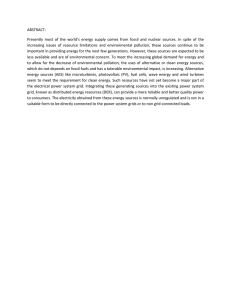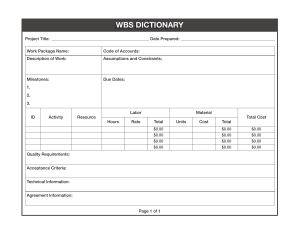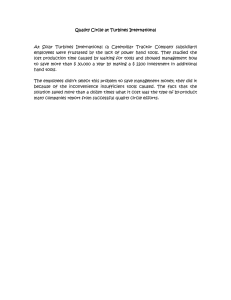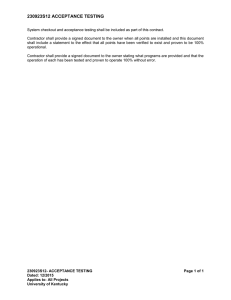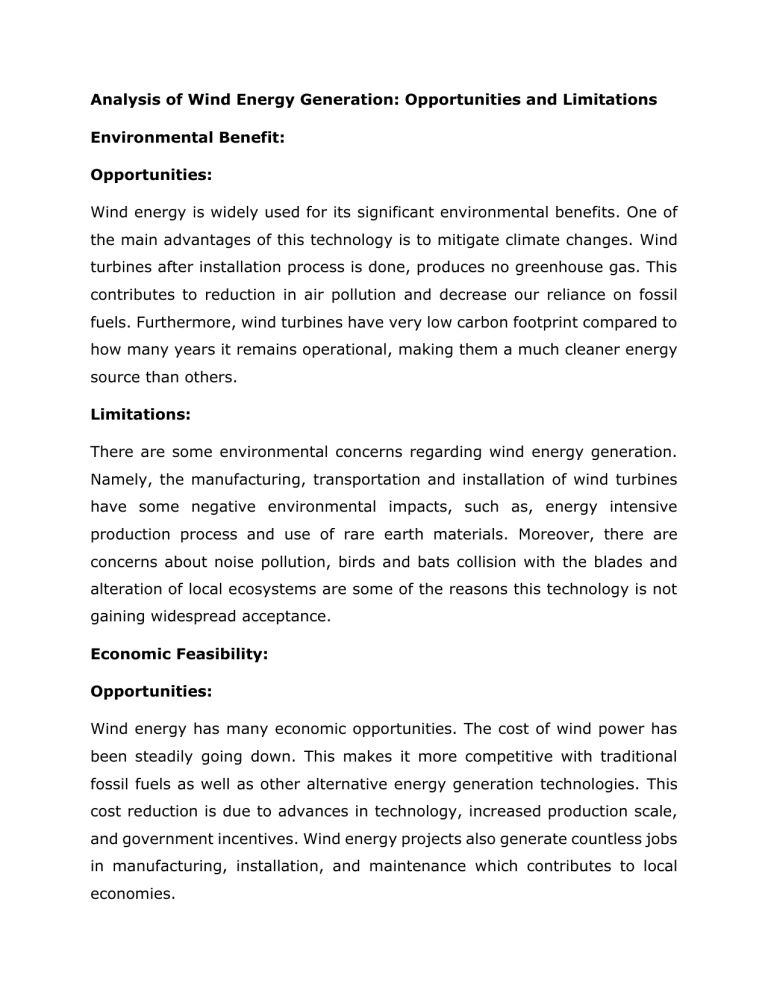
Analysis of Wind Energy Generation: Opportunities and Limitations Environmental Benefit: Opportunities: Wind energy is widely used for its significant environmental benefits. One of the main advantages of this technology is to mitigate climate changes. Wind turbines after installation process is done, produces no greenhouse gas. This contributes to reduction in air pollution and decrease our reliance on fossil fuels. Furthermore, wind turbines have very low carbon footprint compared to how many years it remains operational, making them a much cleaner energy source than others. Limitations: There are some environmental concerns regarding wind energy generation. Namely, the manufacturing, transportation and installation of wind turbines have some negative environmental impacts, such as, energy intensive production process and use of rare earth materials. Moreover, there are concerns about noise pollution, birds and bats collision with the blades and alteration of local ecosystems are some of the reasons this technology is not gaining widespread acceptance. Economic Feasibility: Opportunities: Wind energy has many economic opportunities. The cost of wind power has been steadily going down. This makes it more competitive with traditional fossil fuels as well as other alternative energy generation technologies. This cost reduction is due to advances in technology, increased production scale, and government incentives. Wind energy projects also generate countless jobs in manufacturing, installation, and maintenance which contributes to local economies. Limitations: Some reasons challenge the feasibility of wind energy. The main reason is the initial setup costs for wind farms are very high requiring substantial investment. Also, the inconsistency of wind patterns makes energy generation irregular, so energy storage solutions need to be added on top of it to ensure a continuous and reliable power supply. Additionally, the integration with the existing grid requires upgrades which adds to the overall cost. Public Acceptance: Opportunities: Public acceptance is crucial for any new energy generation technology because of the public’s fear or reluctance. Although wind energy has already gained widespread support, community engagement and involvement in the decisionmaking process for wind energy projects can also enhance further acceptance. Educating the general public more about these technologies, answering questions and dispelling myths through transparent communication could be some essential strategies to do this. Limitations: Public acceptance can go negative in various ways. The visual impact of the wind turbines in a natural valley, noise pollution from the turbines, and fears of adjacent property devaluation can lead to opposition from local communities. Effective communication and strategies can address these concerns and build trust. Furthermore, educating the public about the potential economic benefits of wind energy projects through job creation and community investment programs can improve public perception. Action Plan to Encourage Wind Energy Use: 1. Community Engagement and Education: A comprehensive community engagement and education program is essential to overcome public acceptance barriers. This program includes organizing public consultations, providing educational materials, and using online channels to convey the environmental and economic advantages of wind energy. Involve indigenous communities early in the planning process, soliciting feedback on site selection and addressing concerns directly. Partner with local schools to integrate renewable energy education into the curriculum, fostering a sense of ownership and pride. 2. Financial Incentives and Support: To fast-track the growth of wind energy and overcome the economic barriers, it is imperative to implement financial incentives at both the government and corporate levels. These could include tax breaks, subsidies, or grants that would lower the financial risk for investors. Furthermore, public-private partnerships could help the co-financing of infrastructure and grid integration costs. Additionally, a more favorable financing conditions for wind energy projects could stimulate innovation in energy storage solutions to cope with the variability of wind power. 3. Innovation and Research: Constant investment in research and development is one of the most important aspects of wind energy's success. In addition to addressing environmental issues, this can boost wind energy technology efficiency. One way to lessen the environmental impact of wind farms is to encourage innovation in areas like manufacturing methods, materials, and turbine design. Furthermore, best practices for protecting habitat and conserving species around wind energy facilities can be created and put into action by working with academic institutions and business leaders. Transparency in sharing these developments with the public demonstrates a commitment to reducing any unfavorable consequences on the environment. Conclusion: To sum up, wind energy offers significant benefits in terms of environmental benefit, economic feasibility, and potential for public acceptance. However, it also faces some limitations that need to be addressed through community engagement, financial incentives, and innovation.
